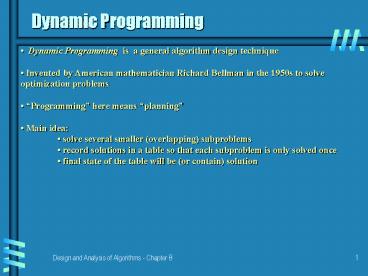Dynamic Programming - PowerPoint PPT Presentation
Title:
Dynamic Programming
Description:
Computing the nth Fibonacci number recursively (top-down): f(n) f(n-1) f(n-2) ... Example: Fibonacci numbers. Computing the nth fibonacci number using bottom ... – PowerPoint PPT presentation
Number of Views:41
Avg rating:3.0/5.0
Title: Dynamic Programming
1
Dynamic Programming
- Dynamic Programming is a general algorithm
design technique - Invented by American mathematician Richard
Bellman in the 1950s to solve optimization
problems - Programming here means planning
- Main idea
- solve several smaller (overlapping) subproblems
- record solutions in a table so that each
subproblem is only solved once - final state of the table will be (or contain)
solution
2
Example Fibonacci numbers
- Recall definition of Fibonacci numbers
- f(0) 0
- f(1) 1
- f(n) f(n-1) f(n-2)
- Computing the nth Fibonacci number recursively
(top-down) - f(n)
- f(n-1)
f(n-2) - f(n-2) f(n-3) f(n-3)
f(n-4) - ...
3
Example Fibonacci numbers
- Computing the nth fibonacci number using
bottom-up iteration - f(0) 0
- f(1) 1
- f(2) 01 1
- f(3) 11 2
- f(4) 12 3
- f(5) 23 5
- f(n-2)
- f(n-1)
- f(n) f(n-1) f(n-2)
4
Examples of Dynamic Programming Algorithms
- Computing binomial coefficients
- Optimal chain matrix multiplication
- Constructing an optimal binary search tree
- Warshalls algorithm for transitive closure
- Floyds algorithms for all-pairs shortest paths
- Some instances of difficult discrete optimization
problems - travelling salesman
- knapsack
5
Warshalls Algorithm Transitive Closure
- Computes the transitive closure of a relation
- (Alternatively all paths in a directed graph)
- Example of transitive closure
0 0 1 0 1 1 1 1 0 0 0 0 1 1 1 1
0 0 1 0 1 0 0 1 0 0 0 0 0 1 0 0
6
Warshalls Algorithm
- Main idea a path exists between two vertices i,
j, iff - there is an edge from i to j or
- there is a path from i to j going through vertex
1 or - there is a path from i to j going through vertex
1 and/or 2 or - there is a path from i to j going through vertex
1, 2, and/or 3 or - ...
- there is a path from i to j going through any of
the other vertices
R0 0 0 1 0 1 0 0 1 0 0 0 0 0 1 0
0
R1 0 0 1 0 1 0 1 1 0 0 0 0 0 1 0 0
R2 0 0 1 0 1 0 1 1 0 0 0 0 1 1 1 1
R3 0 0 1 0 1 0 1 1 0 0 0 0 1 1 1 1
R4 0 0 1 0 1 1 1 1 0 0 0 0 1 1 1 1
7
Warshalls Algorithm
- In the kth stage determine if a path exists
between two vertices i, j using just vertices
among 1,,k - R(k-1)i,j (path
using just 1 ,,k-1) - R(k)i,j or
- (R(k-1)i,k and R(k-1)k,j) (path from
i to k -
and from k to i -
using just 1 ,,k-1)
k
i
kth stage
j
8
Floyds Algorithm All pairs shortest paths
- In a weighted graph, find shortest paths between
every pair of vertices - Same idea construct solution through series of
matrices D(0), D(1), using an initial subset of
the vertices as intermediaries. - Example































